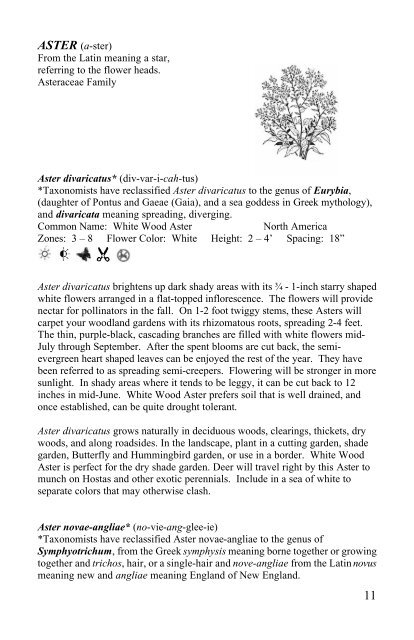perennials - Natives Coming in 2010
perennials - Natives Coming in 2010
perennials - Natives Coming in 2010
Create successful ePaper yourself
Turn your PDF publications into a flip-book with our unique Google optimized e-Paper software.
ASTER (a-ster)<br />
From the Lat<strong>in</strong> mean<strong>in</strong>g a star,<br />
referr<strong>in</strong>g to the flower heads.<br />
Asteraceae Family<br />
Aster divaricatus* (div-var-i-cah-tus)<br />
*Taxonomists have reclassified Aster divaricatus to the genus of Eurybia,<br />
(daughter of Pontus and Gaeae (Gaia), and a sea goddess <strong>in</strong> Greek mythology),<br />
and divaricata mean<strong>in</strong>g spread<strong>in</strong>g, diverg<strong>in</strong>g.<br />
Common Name: White Wood Aster North America<br />
Zones: 3 – 8 Flower Color: White Height: 2 – 4’ Spac<strong>in</strong>g: 18”<br />
Aster divaricatus brightens up dark shady areas with its ¾ - 1-<strong>in</strong>ch starry shaped<br />
white flowers arranged <strong>in</strong> a flat-topped <strong>in</strong>florescence. The flowers will provide<br />
nectar for poll<strong>in</strong>ators <strong>in</strong> the fall. On 1-2 foot twiggy stems, these Asters will<br />
carpet your woodland gardens with its rhizomatous roots, spread<strong>in</strong>g 2-4 feet.<br />
The th<strong>in</strong>, purple-black, cascad<strong>in</strong>g branches are filled with white flowers mid-<br />
July through September. After the spent blooms are cut back, the semievergreen<br />
heart shaped leaves can be enjoyed the rest of the year. They have<br />
been referred to as spread<strong>in</strong>g semi-creepers. Flower<strong>in</strong>g will be stronger <strong>in</strong> more<br />
sunlight. In shady areas where it tends to be leggy, it can be cut back to 12<br />
<strong>in</strong>ches <strong>in</strong> mid-June. White Wood Aster prefers soil that is well dra<strong>in</strong>ed, and<br />
once established, can be quite drought tolerant.<br />
Aster divaricatus grows naturally <strong>in</strong> deciduous woods, clear<strong>in</strong>gs, thickets, dry<br />
woods, and along roadsides. In the landscape, plant <strong>in</strong> a cutt<strong>in</strong>g garden, shade<br />
garden, Butterfly and Humm<strong>in</strong>gbird garden, or use <strong>in</strong> a border. White Wood<br />
Aster is perfect for the dry shade garden. Deer will travel right by this Aster to<br />
munch on Hostas and other exotic <strong>perennials</strong>. Include <strong>in</strong> a sea of white to<br />
separate colors that may otherwise clash.<br />
Aster novae-angliae* (no-vie-ang-glee-ie)<br />
*Taxonomists have reclassified Aster novae-angliae to the genus of<br />
Symphyotrichum, from the Greek symphysis mean<strong>in</strong>g borne together or grow<strong>in</strong>g<br />
together and trichos, hair, or a s<strong>in</strong>gle-hair and nove-angliae from the Lat<strong>in</strong> novus<br />
mean<strong>in</strong>g new and angliae mean<strong>in</strong>g England of New England.<br />
11


